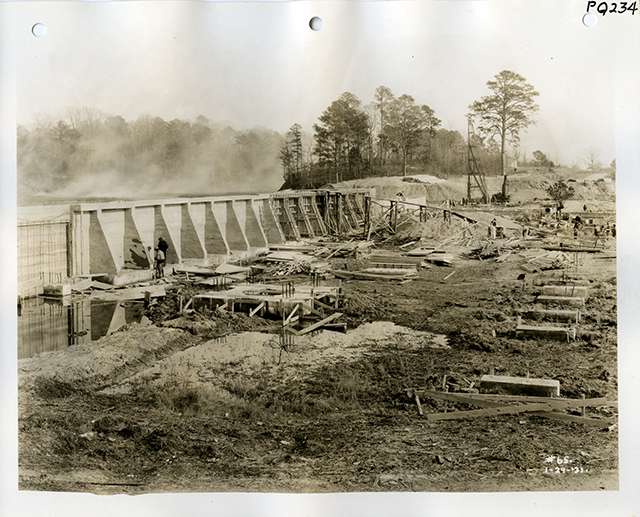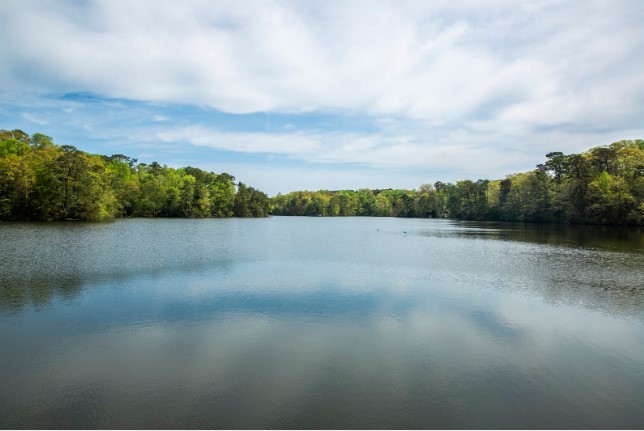
Did you know Virginia has only two natural lakes? The rest are man-made, including our very own Mariners’ Lake! It holds the title as the first, and the oldest, project started on the grounds of The Mariners’ Museum Park. Before the purchase of the land surrounding it, The Mariners’ Lake was a salt marsh creek called Waters Creek, sometimes incorrectly referred to as Watts Creek. You can learn more about that, here! Apart from the vision of creating a maritime museum, Archer Huntington (our founder and owner of the Newport News Shipyard) and his wife Anna Hyatt (renowned sculptor), wanted to create a wildlife sanctuary. They also wanted a place to display several of Anna’s sculptures. The rural setting and proximity to the Shipyard helped to make this spot the ideal location. You can read more about why this area was chosen, here.

Although our official birthday is June 2nd, planning for the Lake and Park began months prior. In December of 1929, internal memos show that land acquisition was already being discussed and negotiations had started. In a memo from Homer Ferguson, President of the Newport News Shipyard, to Archer Huntington:
It now develops that the marsh of Watts Creek can probably be acquired on both sides so that the lake you originally had in mind may be a reality…I am having an estimate made of the cost of the concrete dam to give 4 or 5 feet of water above the marsh level, and think we will be able to acquire all of the marsh area to be flooded by the dam and 1 foot above that height for a very reasonable price.
Over the next few months, the Shipyard staff assigned to the Museum project worked diligently to secure the proper permitting to close Waters Creek and create a lake. By June of 1930, staff began to clear the lake bed of all vegetation and tree stumps. They did so by performing a controlled burn of the area up to the tree line. Clearing would continue until December of 1930.

Huntington envisioned one continuous lake, therefore, Causey’s Mill and its adjoining pond were purchased in July of 1930. The pond was purchased from Warwick County. Collis Huntington, Archer’s father, purchased the Mill and its pond in 1890 in the hopes that it could serve as the County’s water reservoir. That plan was quickly abandoned in favor of a larger reservoir in Lee Hall.

Construction on the dam that would hold the Lake began in November of 1930 by the Virginia Engineering Company and was officially closed in February of 1931. As work on the Dam progressed, the Company turned their attention to the dam at Causey’s Mill. The Pond had been dammed since the late 1600s and as such had acquired a lot of fish over the years. Upon its dam break, the Museum sold 450 German carp, 250 catfish, and four barrels of gizzard shad for $115. We kept 350 bass for the newly formed Lake. The Milldam was removed and a bridge over the Park was put in its place.

The bridge was quite ornate for the time. However, Huntington insisted it have more character than a standard bridge because it was the only road to cut through the Park. It would come to be known as Warwick Boulevard Bridge. Aerial photographs of the Bridge and Dam completed were sent to Huntington by Lloyd Noland, Sr., the president of the Virginia Engineering Company. His son, Lloyd Noland, Jr., is the visionary behind the Noland Trail!


With work on the Dam nearing completion, granite work began. North Carolina granite was used on the walls of the Dam. This is the same stone used on the Arlington Memorial Bridge in D.C.! The Dam was considered complete in June of 1931.


The finishing touches were being put on the bridge that spanned the Dam. But wait! Is something missing in this photograph?

The Lions! We can’t officially call it Lions Bridge if there are no lions guarding it! Anna Hyatt Huntington, Archer’s wife, designed the lions on a smaller scale and Robert Baillie of Closter, New Jersey scaled them up. All four were completed and installed in October of 1932. Can you imagine seeing these drive past you on the road?


The original Board of Trustees named the Lake, Lake Maury after Matthew Fontaine Maury for his contributions as Pathfinder of the Seas. It remained Lake Maury until this year when our current Board of Trustees, together with the Mariners’ staff, decided to better reflect our community and our shared maritime heritage by renaming it The Mariners’ Lake. You can learn more about our change, here.
Over the years, The Mariners’ Lake served as an oasis for wildlife and a temporary storage area for our larger watercraft collection.

As we celebrate the 90th birthday of the Museum and Park, we can’t wait to see how the Lake will flourish in the next 90 years! Stay tuned for more blogs on our history and blow out a virtual candle with us!
